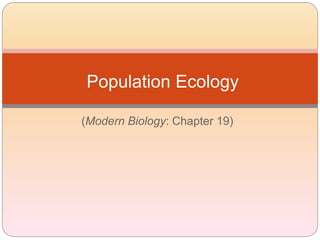Population ecology part 1
•Download as PPTX, PDF•
2 likes•843 views
Introduction to Populations
Report
Share
Report
Share

Recommended
Recommended
More Related Content
What's hot (20)
Similar to Population ecology part 1
Similar to Population ecology part 1 (20)
Ecology- organisms and populations class 12 notes in pfd

Ecology- organisms and populations class 12 notes in pfd
More from vjcummins
More from vjcummins (20)
Recently uploaded
This presentation was provided by William Mattingly of the Smithsonian Institution, during the fourth segment of the NISO training series "AI & Prompt Design." Session Four: Structured Data and Assistants, was held on April 25, 2024.Mattingly "AI & Prompt Design: Structured Data, Assistants, & RAG"

Mattingly "AI & Prompt Design: Structured Data, Assistants, & RAG"National Information Standards Organization (NISO)
APM Welcome
Tuesday 30 April 2024
APM North West Network Conference, Synergies Across Sectors
Presented by:
Professor Adam Boddison OBE, Chief Executive Officer, APM
Conference overview:
https://www.apm.org.uk/community/apm-north-west-branch-conference/
Content description:
APM welcome from CEO
The main conference objective was to promote the Project Management profession with interaction between project practitioners, APM Corporate members, current project management students, academia and all who have an interest in projects.APM Welcome, APM North West Network Conference, Synergies Across Sectors

APM Welcome, APM North West Network Conference, Synergies Across SectorsAssociation for Project Management
This presentation was provided by William Mattingly of the Smithsonian Institution, during the third segment of the NISO training series "AI & Prompt Design." Session Three: Beginning Conversations, was held on April 18, 2024.Mattingly "AI & Prompt Design: The Basics of Prompt Design"

Mattingly "AI & Prompt Design: The Basics of Prompt Design"National Information Standards Organization (NISO)
Recently uploaded (20)
Web & Social Media Analytics Previous Year Question Paper.pdf

Web & Social Media Analytics Previous Year Question Paper.pdf
Mattingly "AI & Prompt Design: Structured Data, Assistants, & RAG"

Mattingly "AI & Prompt Design: Structured Data, Assistants, & RAG"
Measures of Central Tendency: Mean, Median and Mode

Measures of Central Tendency: Mean, Median and Mode
Interactive Powerpoint_How to Master effective communication

Interactive Powerpoint_How to Master effective communication
Beyond the EU: DORA and NIS 2 Directive's Global Impact

Beyond the EU: DORA and NIS 2 Directive's Global Impact
APM Welcome, APM North West Network Conference, Synergies Across Sectors

APM Welcome, APM North West Network Conference, Synergies Across Sectors
Call Girls in Dwarka Mor Delhi Contact Us 9654467111

Call Girls in Dwarka Mor Delhi Contact Us 9654467111
Mattingly "AI & Prompt Design: The Basics of Prompt Design"

Mattingly "AI & Prompt Design: The Basics of Prompt Design"
Population ecology part 1
- 1. (Modern Biology: Chapter 19) Population Ecology
- 2. Properties of Populations Population: a group of organisms of one species in the same area at the same time (defined space and time) 1) Population Size = number of individuals Can be difficult to measure directly
- 3. Properties of Populations 2) Population Density = how crowded a population is Expressed as # of individuals per unit area or volume Ex: United States Population Density (Homo sapiens) 30 people/km2
- 4. Properties of Populations (con’t) 3) Dispersion = the spatial distribution of individuals 3 types: A) Uniform (aka. Even) B) Clumped C) Random
- 5. Population Growth Rate All populations are dynamic. They change in size and composition over time. Scientists who study population dynamics = DEMOGRAPHERS GROWTH RATE of a population is the amount by which a population’s size changes in a given time. Can be positive (Increasing population over time)
- 8. Exponential Growth Describes a population that grows rapidly after only a few generations “J-curve” Larger population = faster growth In reality, resources will run out Limiting Factor: a factor that restrains population growth ALL populations are ultimately limited by their
- 9. Population Regulation Two type of limiting factors have been identified: 1) Density-independent: population density does not matter i.e. weather, floods, fires, climate change The population is reduced by the same proportion regardless of size/density 2) Density-dependent: depend on population density i.e. availability of resources, space
- 10. Logistic Growth Describes a realistic population Accounts for limiting factors “S-Curve” Carrying Capacity: the maximum # of individuals the environment can support over time
Editor's Notes
- Uniform = individuals are separated by a fairly consistent distance. Clumped = individuals are clustered together Random = each individual’s location is independent of the locations of other individuals in the population Factors that impact DIPSERSION: Resource availability Living space Social interactions/behavior